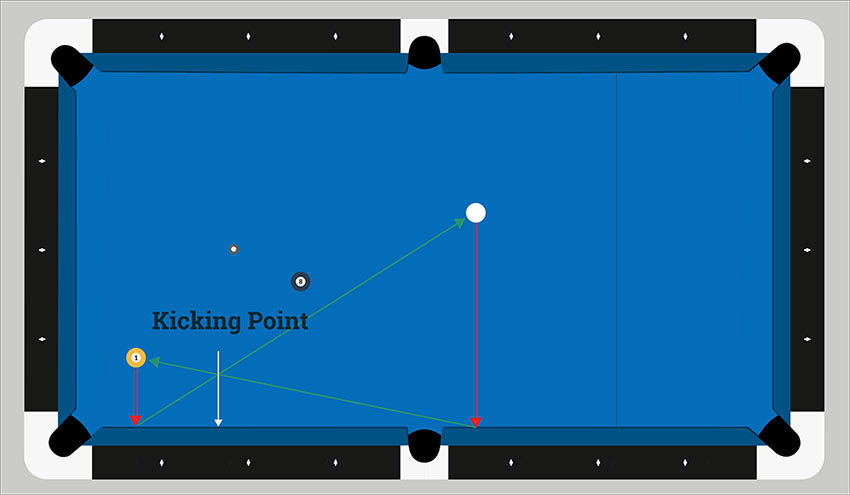When you play pool situations always come up where you can’t see the ball you are trying to hit. You could be playing eight ball and not be able to see a stripe, or you could be playing 9 ball and not be able to see the seven if the other balls are all gone. This can be a real pain, and for many players it can be the bane of thier pool playing existence. However, there is a defense for these situations which is called kicking. Kicking is when you hit a cushion with the cue ball before you hit the object ball. Unfortunately for most people these are nearly impossible to predict, but after reading this tutorial you should find the process much easier, after all, its just a little geometry. (Don’t worry I’m not good at math either, this stuff ain’t too tough.)
Some players play best by feel and they can just see the shot on the table and know where to hit a rail to end up hitting thier object ball to avoid a foul. For those of us who aren’t pros or pool prodigies using a kicking system should work for us just fine instead. This is where the diamond kicking system comes into play. If you didn’t know already, pool tables are marked with diamonds that run across the rails of the table and they help with aiming kicks and banks to make playing easier. The diamond system uses these markings and a few basic principles that will make it easy for you to start kicking like a pro in no time!
The Basics of the diamond system
The all important principle of kicking is that if you hit a cue ball with no spin against a rail, that ball will rebound at the same angle that you hit it at intially. So if the cue ball goes into a rail at a 45 degree and it will rebound off the rail at a 45 degree angle. This sounds simple, but you’ll probably find that looking at a table and figuring out what the mirrored angle is, is more difficult than it sounds. The diamond system takes this main principle and makes it simpler to visualize and execute with some basic math.
Down to Business
Ok, so you’ve heard enough background on the diamond system, now you proably just want me to shut up and tell you how it works! No problemo, here it is. So in order to make 1 rail kicks, which means only hitting one cushion with the cue ball before hitting the object ball all you need to do is measure out to the rail that you are kicking at in a straight line. You need to do the same on the opposite side of the table with the object ball you are trying to hit as well. Once you’ve done that, visualize a diagonal line from each of those point to each respective ball. Those two lines should intersect and from that intersection point draw a line to the rail that you are kicking to and where that line ends up on the rail is where you need to kick towards in order to hit the ball. I know that sounds complicated, but once you try it a couple times you’ll find its really easy.
Here’s a diagram so you can see how simple it is:

All this system is doing is utilizing the angle in angle out rule we explained above and making it easier for you to find that point. After a while of using this system you won’t need to use it anymore and you’ll be able to work off of just feel. Keep in mind that different conditions can alter how any system works which we’ll explain more about later in this article, so if you don’t hit the ball the first time it’s not that you are using the system wrong, but that you aren’t accounting for a variable in your conditions or playing style. Here is a short video of this system in action so you can see how it works in a real game situation.
Conditions to look out for.
As we mentioned earlier systems aren’t perfect and it can be frustrating if your not aware of different factors that can affect your kick which can cause you to miss. One of the biggest factors is spin on the cue ball. Unwanted spin can alter the direction of the cue ball which can make your shot innacurate. For more advanced players they use this spin to help them in situations in order to hit a ball, but for now you should try to practice on hitting kicks with no spin on the ball.
The other factor in kicking is the speed that you hit the cue ball. Even though geometry is a big part of playing pool, physics plays an even bigger part. In a perfect world the angle that the cue ball hits the rail would be the exact same angle that it comes out of the rail every time. But because of physics and the fact that the rails are made out of rubber the rail will compress which gives the ball a narrower angle off impact than would be originally expected. And if you hit the cue ball slow it will have a wider angle than intended as well, so the rule of thumb is to hit at medium speed if you want to achieve perfect angle in angle out results.
